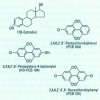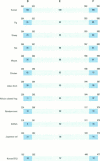Abstract
Several studies have reported that polychlorinated biphenyls (PCBs) exhibit estrogenic activity; however, it is not clear if these responses are associated with the polychlorinated hydrocarbon or its hydroxylated metabolite. In order to further test this hypothesis, a battery of in vitro and in vivo assays were used to investigate the estrogenic and antiestrogenic activities of 2,4,6,2',6'-pentachlorobiphenyl (PCB 104), its para-hydroxylated derivative 2,4,6,2',6'-pentachloro-4-biphenylol (HO-PCB 104), and its para-chlorinated derivative 2,4,6,2',4',6'-hexachlorobiphenyl (PCB 155). PCB 104 was found to 1) compete with tritiated 17beta-estradiol (E2) for binding to the mouse uterine estrogen receptor (ER); 2) induce gene expression in MCF-7 human breast cancer cells transiently transfected with the Gal4-human ER chimeric construct (Gal4-HEGO) and the Gal4-regulated luciferase reporter gene (17m5-G-Luc); and 3) increase MCF-7 cell proliferation in a dose-dependent manner. HO-PCB 104 exhibited greater estrogenic activity than PCB 104 in the in vitro assays examined. However, gas chromatographic-mass spectrophotometric analysis of extracts prepared from MCF-7 cells incubated with PCB 104 failed to detect the presence of the expected major metabolite HO-PCB 104. The estrogenic activity of the para-chlorinated derivative, PCB 155, was minimal compared to PCB 104 and HO-PCB 104, but it did exhibit significant antiestrogenic activity following co-treatment with 1 nM E2. Co-treatment of PCB 104 with 1 nM E2 had no effect on reporter gene expression compared to E2 alone, while 10 microM HO-PCB 104 exhibited additivity with 1 nM E2. At a dose of 202 mg/kg,PCB 104 increased uterine wet weight in ovariectomized CD-1 mice and induced vaginal epithelial cell cornification at 202, 16, and 1.7 mg/kg in a dose-dependent manner. These studies demonstrate that in addition to the hydroxylated metabolites, selected parent PCB congeners may also exhibit estrogenic and antiestrogenic activities.
Full text
PDF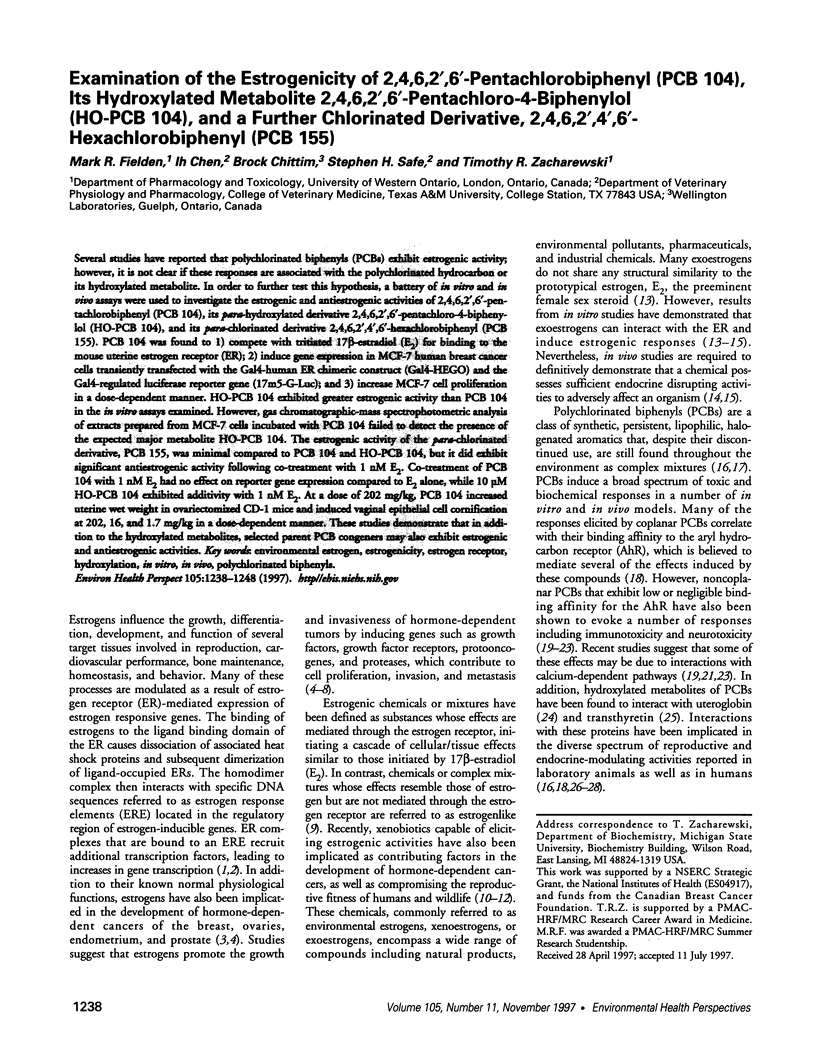
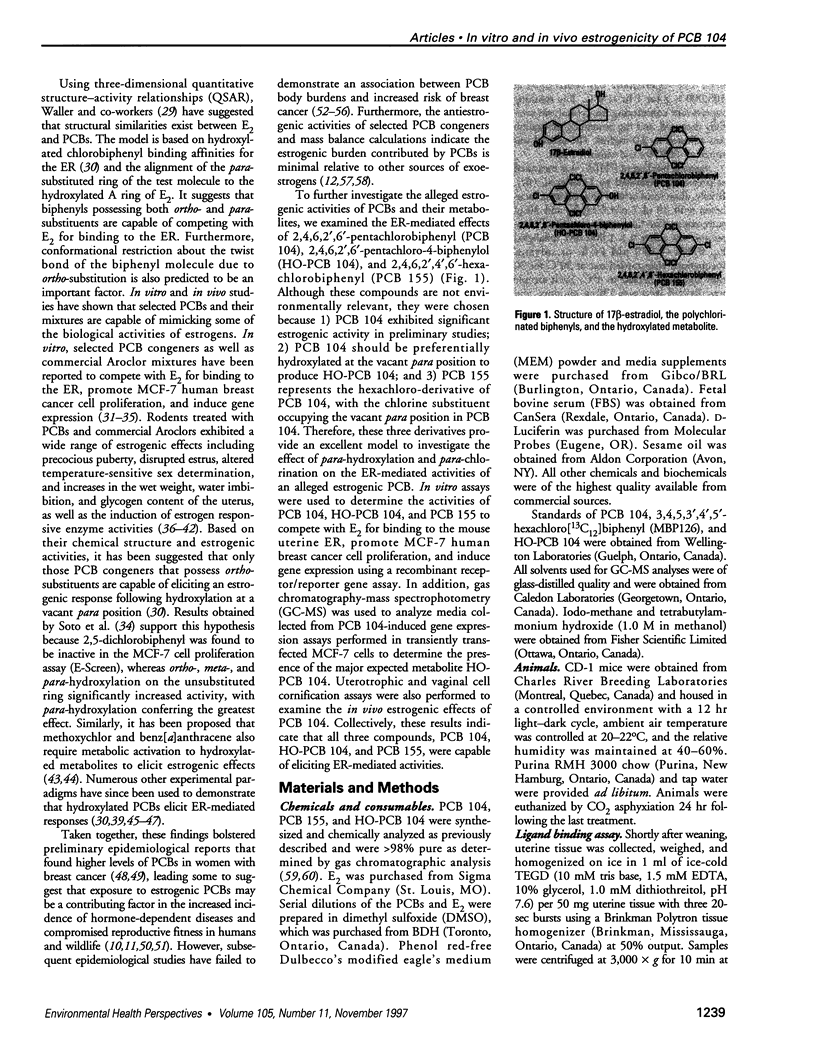

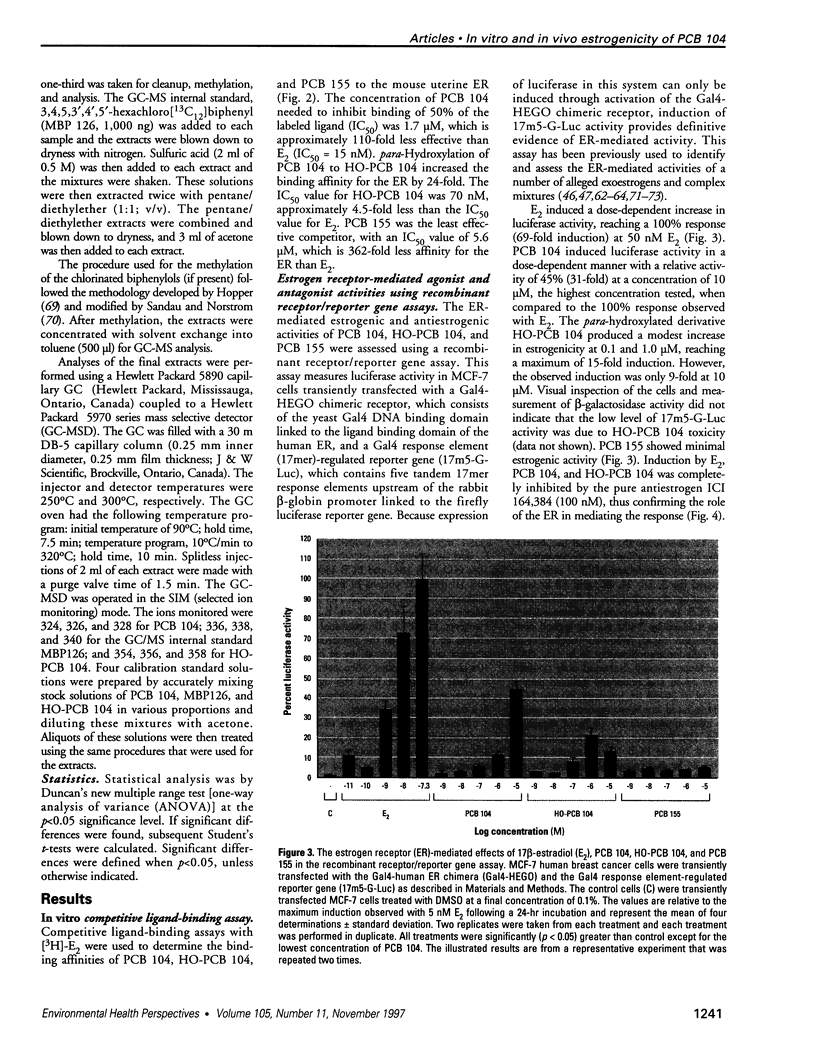
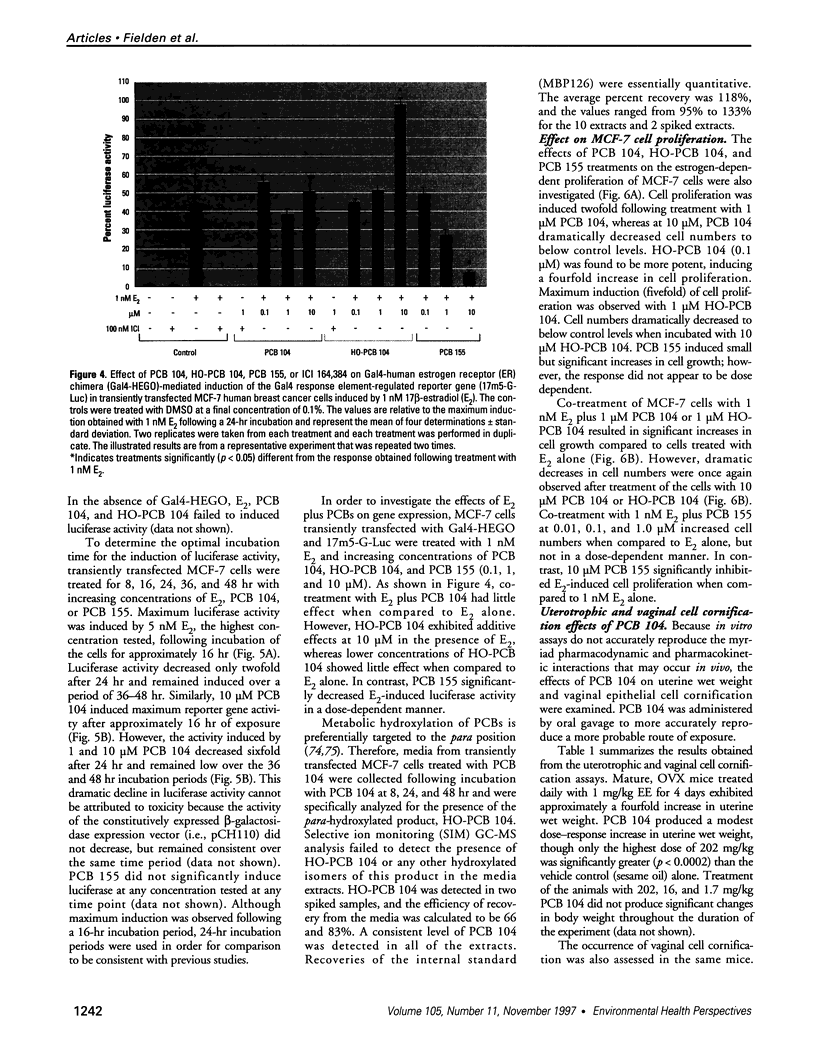

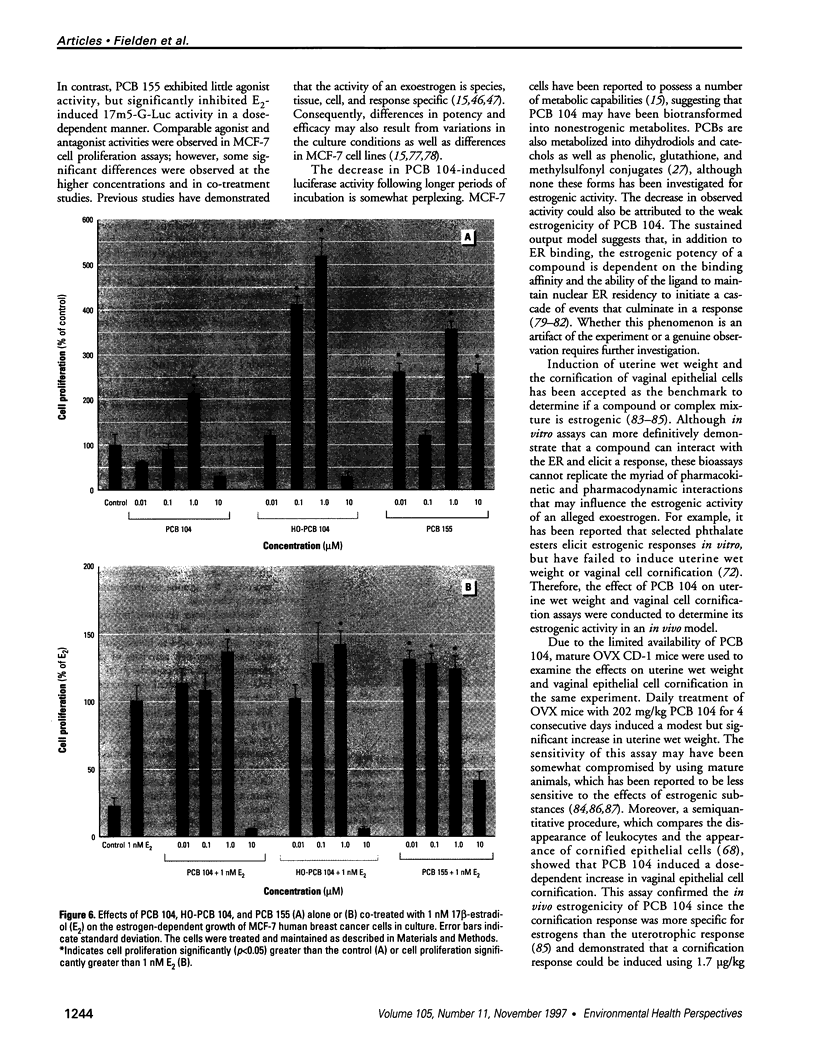
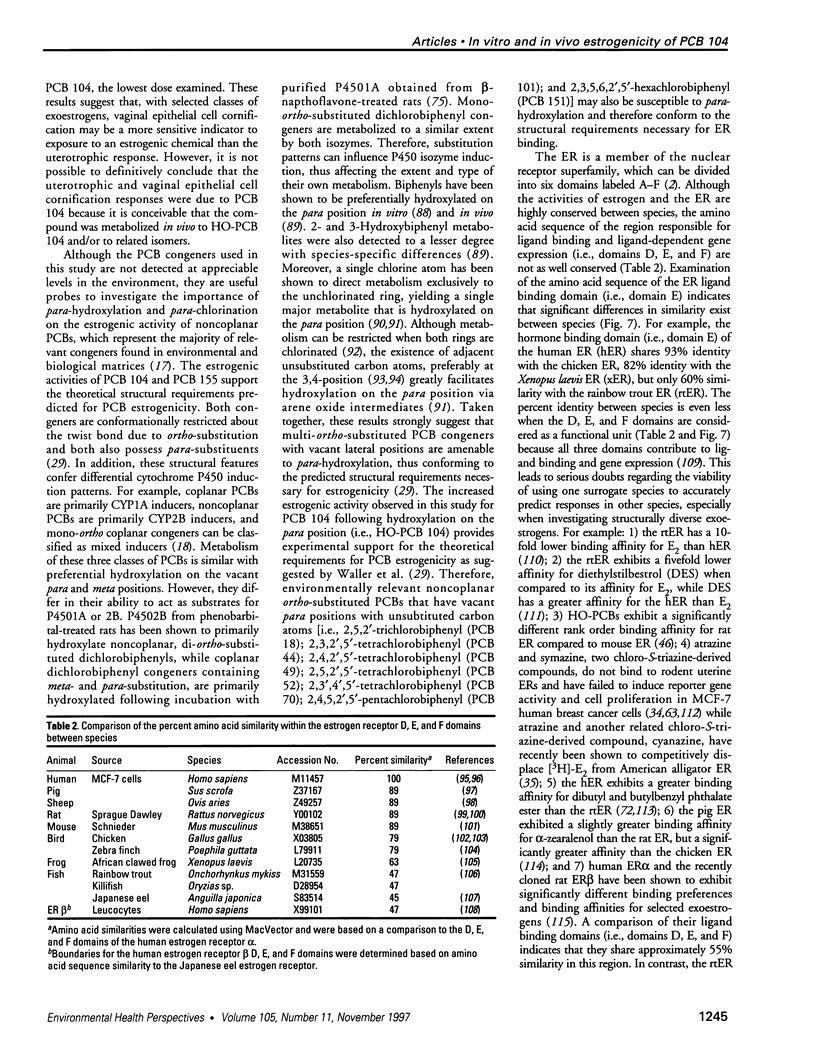
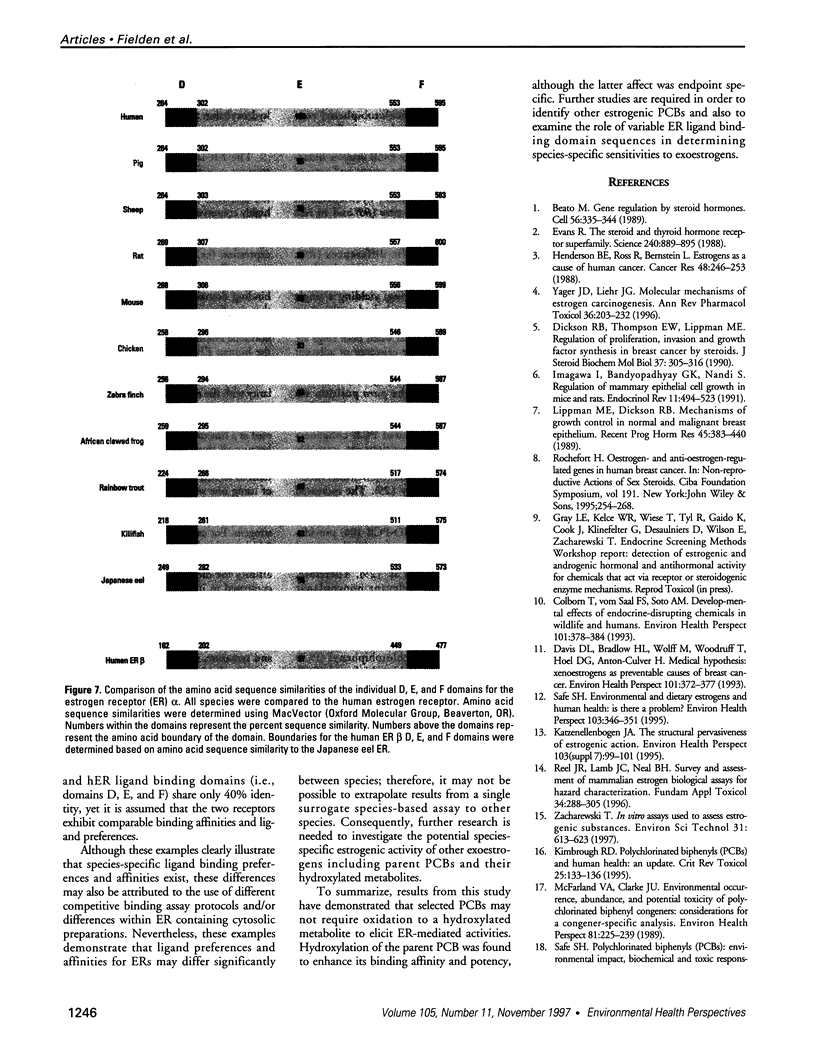
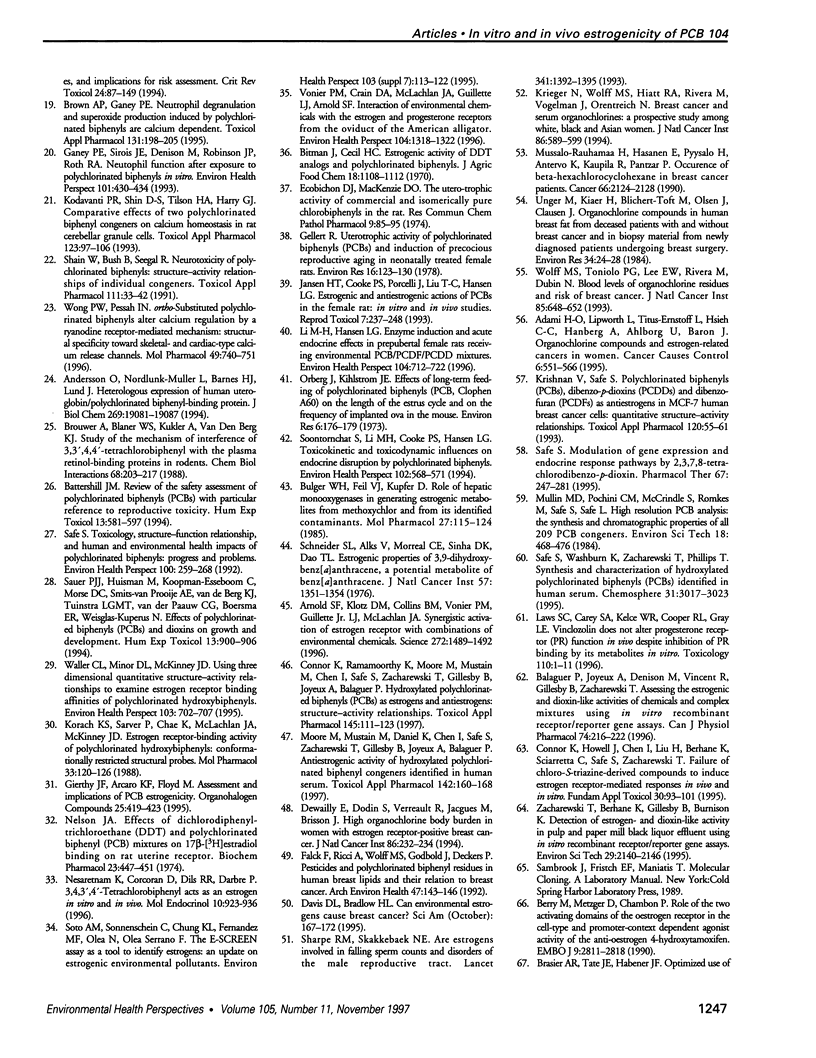
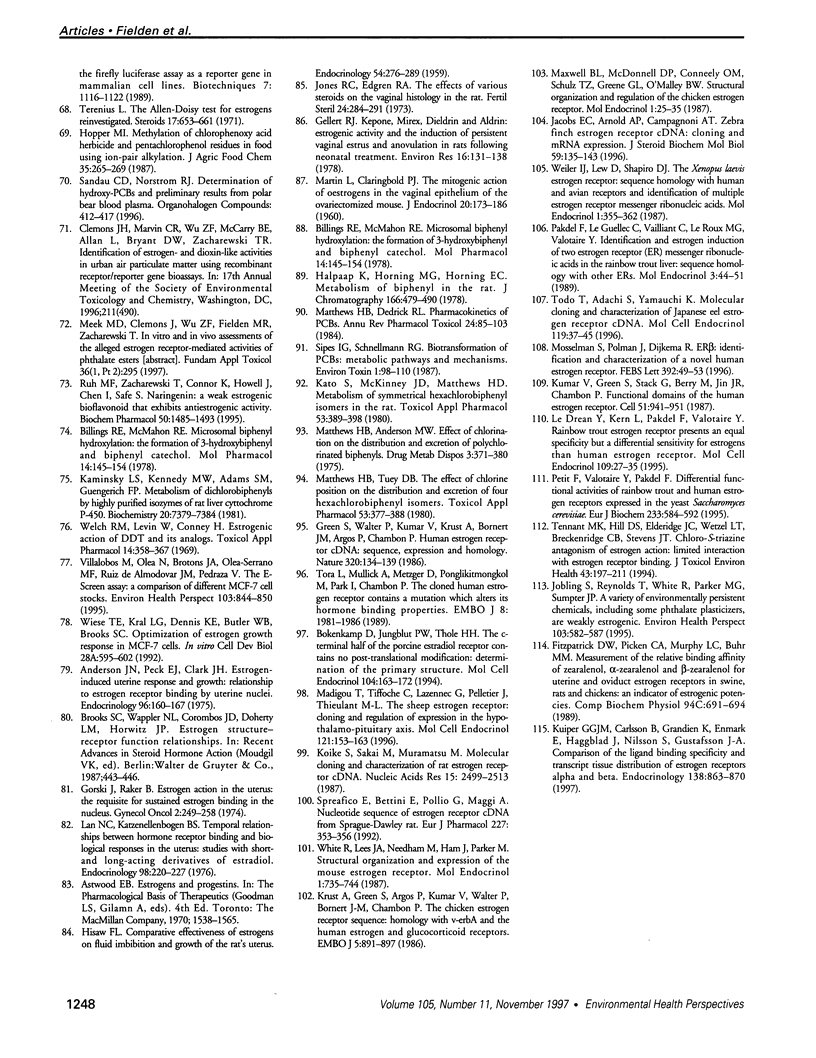
Images in this article
Selected References
These references are in PubMed. This may not be the complete list of references from this article.
- Adami H. O., Lipworth L., Titus-Ernstoff L., Hsieh C. C., Hanberg A., Ahlborg U., Baron J., Trichopoulos D. Organochlorine compounds and estrogen-related cancers in women. Cancer Causes Control. 1995 Nov;6(6):551–566. doi: 10.1007/BF00054165. [DOI] [PubMed] [Google Scholar]
- Anderson J. N., Peck E. J., Jr, Clark J. H. Estrogen-induced uterine responses and growth: relationship to receptor estrogen binding by uterine nuclei. Endocrinology. 1975 Jan;96(1):160–167. doi: 10.1210/endo-96-1-160. [DOI] [PubMed] [Google Scholar]
- Andersson O., Nordlund-Möller L., Barnes H. J., Lund J. Heterologous expression of human uteroglobin/polychlorinated biphenyl-binding protein. Determination of ligand binding parameters and mechanism of phospholipase A2 inhibition in vitro. J Biol Chem. 1994 Jul 22;269(29):19081–19087. [PubMed] [Google Scholar]
- Arnold S. F., Klotz D. M., Collins B. M., Vonier P. M., Guillette L. J., Jr, McLachlan J. A. Synergistic activation of estrogen receptor with combinations of environmental chemicals. Science. 1996 Jun 7;272(5267):1489–1492. doi: 10.1126/science.272.5267.1489. [DOI] [PubMed] [Google Scholar]
- Balaguer P., Joyeux A., Denison M. S., Vincent R., Gillesby B. E., Zacharewski T. Assessing the estrogenic and dioxin-like activities of chemicals and complex mixtures using in vitro recombinant receptor-reporter gene assays. Can J Physiol Pharmacol. 1996 Feb;74(2):216–222. [PubMed] [Google Scholar]
- Battershill J. M. Review of the safety assessment of polychlorinated biphenyls (PCBs) with particular reference to reproductive toxicity. Hum Exp Toxicol. 1994 Sep;13(9):581–597. doi: 10.1177/096032719401300901. [DOI] [PubMed] [Google Scholar]
- Beato M. Gene regulation by steroid hormones. Cell. 1989 Feb 10;56(3):335–344. doi: 10.1016/0092-8674(89)90237-7. [DOI] [PubMed] [Google Scholar]
- Berry M., Metzger D., Chambon P. Role of the two activating domains of the oestrogen receptor in the cell-type and promoter-context dependent agonistic activity of the anti-oestrogen 4-hydroxytamoxifen. EMBO J. 1990 Sep;9(9):2811–2818. doi: 10.1002/j.1460-2075.1990.tb07469.x. [DOI] [PMC free article] [PubMed] [Google Scholar]
- Billings R. E., McMahon R. E. Microsomal biphenyl hydroxylation: the formation of 3- hydroxybiphenyl and biphenyl catechol. Mol Pharmacol. 1978 Jan;14(1):145–154. [PubMed] [Google Scholar]
- Billings R. E., McMahon R. E. Microsomal biphenyl hydroxylation: the formation of 3- hydroxybiphenyl and biphenyl catechol. Mol Pharmacol. 1978 Jan;14(1):145–154. [PubMed] [Google Scholar]
- Bitman J., Cecil H. C. Estrogenic activity of DDT analogs and polychlorinated biphenyls. J Agric Food Chem. 1970 Nov-Dec;18(6):1108–1112. doi: 10.1021/jf60172a019. [DOI] [PubMed] [Google Scholar]
- Brouwer A., Blaner W. S., Kukler A., Van den Berg K. J. Study on the mechanism of interference of 3,4,3',4'-tetrachlorobiphenyl with the plasma retinol-binding proteins in rodents. Chem Biol Interact. 1988;68(3-4):203–217. doi: 10.1016/0009-2797(88)90017-8. [DOI] [PubMed] [Google Scholar]
- Brown A. P., Ganey P. E. Neutrophil degranulation and superoxide production induced by polychlorinated biphenyls are calcium dependent. Toxicol Appl Pharmacol. 1995 Apr;131(2):198–205. doi: 10.1006/taap.1995.1062. [DOI] [PubMed] [Google Scholar]
- Bulger W. H., Feil V. J., Kupfer D. Role of hepatic monooxygenases in generating estrogenic metabolites from methoxychlor and from its identified contaminants. Mol Pharmacol. 1985 Jan;27(1):115–124. [PubMed] [Google Scholar]
- Bökenkamp D., Jungblut P. W., Thole H. H. The C-terminal half of the porcine estradiol receptor contains no post-translational modification: determination of the primary structure. Mol Cell Endocrinol. 1994 Sep;104(2):163–172. doi: 10.1016/0303-7207(94)90119-8. [DOI] [PubMed] [Google Scholar]
- Colborn T., vom Saal F. S., Soto A. M. Developmental effects of endocrine-disrupting chemicals in wildlife and humans. Environ Health Perspect. 1993 Oct;101(5):378–384. doi: 10.1289/ehp.93101378. [DOI] [PMC free article] [PubMed] [Google Scholar]
- Connor K., Howell J., Chen I., Liu H., Berhane K., Sciarretta C., Safe S., Zacharewski T. Failure of chloro-S-triazine-derived compounds to induce estrogen receptor-mediated responses in vivo and in vitro. Fundam Appl Toxicol. 1996 Mar;30(1):93–101. [PubMed] [Google Scholar]
- Connor K., Ramamoorthy K., Moore M., Mustain M., Chen I., Safe S., Zacharewski T., Gillesby B., Joyeux A., Balaguer P. Hydroxylated polychlorinated biphenyls (PCBs) as estrogens and antiestrogens: structure-activity relationships. Toxicol Appl Pharmacol. 1997 Jul;145(1):111–123. doi: 10.1006/taap.1997.8169. [DOI] [PubMed] [Google Scholar]
- Davis D. L., Bradlow H. L., Wolff M., Woodruff T., Hoel D. G., Anton-Culver H. Medical hypothesis: xenoestrogens as preventable causes of breast cancer. Environ Health Perspect. 1993 Oct;101(5):372–377. doi: 10.1289/ehp.93101372. [DOI] [PMC free article] [PubMed] [Google Scholar]
- Dewailly E., Dodin S., Verreault R., Ayotte P., Sauvé L., Morin J., Brisson J. High organochlorine body burden in women with estrogen receptor-positive breast cancer. J Natl Cancer Inst. 1994 Feb 2;86(3):232–234. doi: 10.1093/jnci/86.3.232. [DOI] [PubMed] [Google Scholar]
- Dickson R. B., Thompson E. W., Lippman M. E. Regulation of proliferation, invasion and growth factor synthesis in breast cancer by steroids. J Steroid Biochem Mol Biol. 1990 Nov 20;37(3):305–316. doi: 10.1016/0960-0760(90)90479-5. [DOI] [PubMed] [Google Scholar]
- Ecobichon D. J., MacKenzie D. O. The uterotropic activity of commercial and isomerically-pure chlorobiphenyls in the rat. Res Commun Chem Pathol Pharmacol. 1974 Sep;9(1):85–95. [PubMed] [Google Scholar]
- Evans R. M. The steroid and thyroid hormone receptor superfamily. Science. 1988 May 13;240(4854):889–895. doi: 10.1126/science.3283939. [DOI] [PMC free article] [PubMed] [Google Scholar]
- Falck F., Jr, Ricci A., Jr, Wolff M. S., Godbold J., Deckers P. Pesticides and polychlorinated biphenyl residues in human breast lipids and their relation to breast cancer. Arch Environ Health. 1992 Mar-Apr;47(2):143–146. [PubMed] [Google Scholar]
- Fitzpatrick D. W., Picken C. A., Murphy L. C., Buhr M. M. Measurement of the relative binding affinity of zearalenone, alpha-zearalenol and beta-zearalenol for uterine and oviduct estrogen receptors in swine, rats and chickens: an indicator of estrogenic potencies. Comp Biochem Physiol C. 1989;94(2):691–694. doi: 10.1016/0742-8413(89)90133-3. [DOI] [PubMed] [Google Scholar]
- Ganey P. E., Sirois J. E., Denison M., Robinson J. P., Roth R. A. Neutrophil function after exposure to polychlorinated biphenyls in vitro. Environ Health Perspect. 1993 Oct;101(5):430–434. doi: 10.1289/ehp.93101430. [DOI] [PMC free article] [PubMed] [Google Scholar]
- Gellert R. J. Kepone, mirex, dieldrin, and aldrin: estrogenic activity and the induction of persistent vaginal estrus and anovulation in rats following neonatal treatment. Environ Res. 1978 Jul;16(1-3):131–138. doi: 10.1016/0013-9351(78)90150-0. [DOI] [PubMed] [Google Scholar]
- Gellert R. J. Uterotrophic activity of polychlorinated biphenyls (PCB) and induction of precocious reproductive aging in neonatally treated female rats. Environ Res. 1978 Jul;16(1-3):123–130. doi: 10.1016/0013-9351(78)90149-4. [DOI] [PubMed] [Google Scholar]
- Gorski J., Raker B. Estrogen action in the uterus: the requisite for sustained estrogen binding in the nucleus. Gynecol Oncol. 1974 Aug;2(2-3):249–258. doi: 10.1016/0090-8258(74)90014-6. [DOI] [PubMed] [Google Scholar]
- Green S., Walter P., Kumar V., Krust A., Bornert J. M., Argos P., Chambon P. Human oestrogen receptor cDNA: sequence, expression and homology to v-erb-A. Nature. 1986 Mar 13;320(6058):134–139. doi: 10.1038/320134a0. [DOI] [PubMed] [Google Scholar]
- HISAW F. L., Jr Comparative effectiveness of estrogens on fluid imbibition and growth of the rat's uterus. Endocrinology. 1959 Feb;64(2):276–289. doi: 10.1210/endo-64-2-276. [DOI] [PubMed] [Google Scholar]
- Halpaap K., Horning M. G., Horning E. C. Metabolism of biphenyl in the rat. J Chromatogr. 1978 Dec 11;166(2):479–490. doi: 10.1016/s0021-9673(00)95631-0. [DOI] [PubMed] [Google Scholar]
- Henderson B. E., Ross R., Bernstein L. Estrogens as a cause of human cancer: the Richard and Hinda Rosenthal Foundation award lecture. Cancer Res. 1988 Jan 15;48(2):246–253. [PubMed] [Google Scholar]
- Imagawa W., Bandyopadhyay G. K., Nandi S. Regulation of mammary epithelial cell growth in mice and rats. Endocr Rev. 1990 Nov;11(4):494–523. doi: 10.1210/edrv-11-4-494. [DOI] [PubMed] [Google Scholar]
- Jacobs E. C., Arnold A. P., Campagnoni A. T. Zebra finch estrogen receptor cDNA: cloning and mRNA expression. J Steroid Biochem Mol Biol. 1996 Oct;59(2):135–145. doi: 10.1016/s0960-0760(96)00096-9. [DOI] [PubMed] [Google Scholar]
- Jansen H. T., Cooke P. S., Porcelli J., Liu T. C., Hansen L. G. Estrogenic and antiestrogenic actions of PCBs in the female rat: in vitro and in vivo studies. Reprod Toxicol. 1993 May-Jun;7(3):237–248. doi: 10.1016/0890-6238(93)90230-5. [DOI] [PubMed] [Google Scholar]
- Jobling S., Reynolds T., White R., Parker M. G., Sumpter J. P. A variety of environmentally persistent chemicals, including some phthalate plasticizers, are weakly estrogenic. Environ Health Perspect. 1995 Jun;103(6):582–587. doi: 10.1289/ehp.95103582. [DOI] [PMC free article] [PubMed] [Google Scholar]
- Jones R. C., Edgren R. A. The effects of various steroids on the vaginal histology in the rat. Fertil Steril. 1973 Apr;24(4):284–291. doi: 10.1016/s0015-0282(16)39613-3. [DOI] [PubMed] [Google Scholar]
- Kaminsky L. S., Kennedy M. W., Adams S. M., Guengerich F. P. Metabolism of dichlorobiphenyls by highly purified isozymes of rat liver cytochrome P-450. Biochemistry. 1981 Dec 22;20(26):7379–7384. doi: 10.1021/bi00529a009. [DOI] [PubMed] [Google Scholar]
- Kato S., McKinney J. D., Matthews H. B. Metabolism of symmetrical hexachlorobiphenyl isomers in the rat. Toxicol Appl Pharmacol. 1980 May;53(3):389–398. doi: 10.1016/0041-008x(80)90352-x. [DOI] [PubMed] [Google Scholar]
- Katzenellenbogen J. A. The structural pervasiveness of estrogenic activity. Environ Health Perspect. 1995 Oct;103 (Suppl 7):99–101. doi: 10.1289/ehp.95103s799. [DOI] [PMC free article] [PubMed] [Google Scholar]
- Kimbrough R. D. Polychlorinated biphenyls (PCBs) and human health: an update. Crit Rev Toxicol. 1995;25(2):133–163. doi: 10.3109/10408449509021611. [DOI] [PubMed] [Google Scholar]
- Kodavanti P. R., Shin D. S., Tilson H. A., Harry G. J. Comparative effects of two polychlorinated biphenyl congeners on calcium homeostasis in rat cerebellar granule cells. Toxicol Appl Pharmacol. 1993 Nov;123(1):97–106. doi: 10.1006/taap.1993.1226. [DOI] [PubMed] [Google Scholar]
- Koike S., Sakai M., Muramatsu M. Molecular cloning and characterization of rat estrogen receptor cDNA. Nucleic Acids Res. 1987 Mar 25;15(6):2499–2513. doi: 10.1093/nar/15.6.2499. [DOI] [PMC free article] [PubMed] [Google Scholar]
- Korach K. S., Sarver P., Chae K., McLachlan J. A., McKinney J. D. Estrogen receptor-binding activity of polychlorinated hydroxybiphenyls: conformationally restricted structural probes. Mol Pharmacol. 1988 Jan;33(1):120–126. [PubMed] [Google Scholar]
- Krieger N., Wolff M. S., Hiatt R. A., Rivera M., Vogelman J., Orentreich N. Breast cancer and serum organochlorines: a prospective study among white, black, and Asian women. J Natl Cancer Inst. 1994 Apr 20;86(8):589–599. doi: 10.1093/jnci/86.8.589. [DOI] [PubMed] [Google Scholar]
- Krishnan V., Safe S. Polychlorinated biphenyls (PCBs), dibenzo-p-dioxins (PCDDs), and dibenzofurans (PCDFs) as antiestrogens in MCF-7 human breast cancer cells: quantitative structure-activity relationships. Toxicol Appl Pharmacol. 1993 May;120(1):55–61. doi: 10.1006/taap.1993.1086. [DOI] [PubMed] [Google Scholar]
- Krust A., Green S., Argos P., Kumar V., Walter P., Bornert J. M., Chambon P. The chicken oestrogen receptor sequence: homology with v-erbA and the human oestrogen and glucocorticoid receptors. EMBO J. 1986 May;5(5):891–897. doi: 10.1002/j.1460-2075.1986.tb04300.x. [DOI] [PMC free article] [PubMed] [Google Scholar]
- Kuiper G. G., Carlsson B., Grandien K., Enmark E., Häggblad J., Nilsson S., Gustafsson J. A. Comparison of the ligand binding specificity and transcript tissue distribution of estrogen receptors alpha and beta. Endocrinology. 1997 Mar;138(3):863–870. doi: 10.1210/endo.138.3.4979. [DOI] [PubMed] [Google Scholar]
- Kumar V., Green S., Stack G., Berry M., Jin J. R., Chambon P. Functional domains of the human estrogen receptor. Cell. 1987 Dec 24;51(6):941–951. doi: 10.1016/0092-8674(87)90581-2. [DOI] [PubMed] [Google Scholar]
- Lan N. C., Katzenellenbogen B. S. Temporal relationships between hormone receptor binding and biological responses in the uterus: studies with short- and long-acting derivatives of estriol. Endocrinology. 1976 Jan;98(1):220–227. doi: 10.1210/endo-98-1-220. [DOI] [PubMed] [Google Scholar]
- Le Dréan Y., Kern L., Pakdel F., Valotaire Y. Rainbow trout estrogen receptor presents an equal specificity but a differential sensitivity for estrogens than human estrogen receptor. Mol Cell Endocrinol. 1995 Mar;109(1):27–35. doi: 10.1016/0303-7207(95)03482-m. [DOI] [PubMed] [Google Scholar]
- Li M. H., Hansen L. G. Enzyme induction and acute endocrine effects in prepubertal female rats receiving environmental PCB/PCDF/PCDD mixtures. Environ Health Perspect. 1996 Jul;104(7):712–722. doi: 10.1289/ehp.96104712. [DOI] [PMC free article] [PubMed] [Google Scholar]
- Lippman M. E., Dickson R. B. Mechanisms of growth control in normal and malignant breast epithelium. Recent Prog Horm Res. 1989;45:383–440. doi: 10.1016/b978-0-12-571145-6.50012-1. [DOI] [PubMed] [Google Scholar]
- MARTIN L., CLARINGBOLD P. J. The mitogenic action of oestrogens in the vaginal epithelium of the ovariectomized mouse. J Endocrinol. 1960 May;20:173–186. doi: 10.1677/joe.0.0200173. [DOI] [PubMed] [Google Scholar]
- Madigou T., Tiffoche C., Lazennec G., Pelletier J., Thieulant M. L. The sheep estrogen receptor: cloning and regulation of expression in the hypothalamo-pituitary axis. Mol Cell Endocrinol. 1996 Aug 9;121(2):153–163. doi: 10.1016/0303-7207(96)03860-9. [DOI] [PubMed] [Google Scholar]
- Mathews H. B., Anderson M. W. Effect of chlorination on the distribution and excretion of polychlorinated biphenyls. Drug Metab Dispos. 1975 Sep-Oct;3(5):371–380. [PubMed] [Google Scholar]
- Matthews H. B., Dedrick R. L. Pharmacokinetics of PCBs. Annu Rev Pharmacol Toxicol. 1984;24:85–103. doi: 10.1146/annurev.pa.24.040184.000505. [DOI] [PubMed] [Google Scholar]
- Matthews H. B., Tuey D. B. The effect of chlorine position on the distribution and excretion of four hexachlorobiphenyl isomers. Toxicol Appl Pharmacol. 1980 May;53(3):377–388. doi: 10.1016/0041-008x(80)90351-8. [DOI] [PubMed] [Google Scholar]
- Maxwell B. L., McDonnell D. P., Conneely O. M., Schulz T. Z., Greene G. L., O'Malley B. W. Structural organization and regulation of the chicken estrogen receptor. Mol Endocrinol. 1987 Jan;1(1):25–35. doi: 10.1210/mend-1-1-25. [DOI] [PubMed] [Google Scholar]
- McFarland V. A., Clarke J. U. Environmental occurrence, abundance, and potential toxicity of polychlorinated biphenyl congeners: considerations for a congener-specific analysis. Environ Health Perspect. 1989 May;81:225–239. doi: 10.1289/ehp.8981225. [DOI] [PMC free article] [PubMed] [Google Scholar]
- Moore M., Mustain M., Daniel K., Chen I., Safe S., Zacharewski T., Gillesby B., Joyeux A., Balaguer P. Antiestrogenic activity of hydroxylated polychlorinated biphenyl congeners identified in human serum. Toxicol Appl Pharmacol. 1997 Jan;142(1):160–168. doi: 10.1006/taap.1996.8022. [DOI] [PubMed] [Google Scholar]
- Mosselman S., Polman J., Dijkema R. ER beta: identification and characterization of a novel human estrogen receptor. FEBS Lett. 1996 Aug 19;392(1):49–53. doi: 10.1016/0014-5793(96)00782-x. [DOI] [PubMed] [Google Scholar]
- Mussalo-Rauhamaa H., Häsänen E., Pyysalo H., Antervo K., Kauppila R., Pantzar P. Occurrence of beta-hexachlorocyclohexane in breast cancer patients. Cancer. 1990 Nov 15;66(10):2124–2128. doi: 10.1002/1097-0142(19901115)66:10<2124::aid-cncr2820661014>3.0.co;2-a. [DOI] [PubMed] [Google Scholar]
- Nelson J. A. Effects of dichlorodiphenyltrichloroethane (DDT) analogs and polychlorinated biphenyl (PCB) mixtures on 17beta-(3H)estradiol binding to rat uterine receptor. Biochem Pharmacol. 1974 Jan 15;23(2):447–451. doi: 10.1016/0006-2952(74)90436-5. [DOI] [PubMed] [Google Scholar]
- Nesaretnam K., Corcoran D., Dils R. R., Darbre P. 3,4,3',4'-Tetrachlorobiphenyl acts as an estrogen in vitro and in vivo. Mol Endocrinol. 1996 Aug;10(8):923–936. doi: 10.1210/mend.10.8.8843409. [DOI] [PubMed] [Google Scholar]
- Olin K. L., Cherr G. N., Rifkin E., Keen C. L. The effects of some redox-active metals and reactive aldehydes on DNA-protein cross-links in vitro. Toxicology. 1996 Jun 17;110(1-3):1–8. doi: 10.1016/0300-483x(96)03318-5. [DOI] [PubMed] [Google Scholar]
- Orberg J., Kihlström J. E. Effects of long-term feeding of polychlorinated biphenyls (PCB, Clophen A 60) on the length of the oestrous cycle and on the frequency of implanted ova in the mouse. Environ Res. 1973 Jun;6(2):176–179. doi: 10.1016/0013-9351(73)90031-5. [DOI] [PubMed] [Google Scholar]
- Pakdel F., Le Guellec C., Vaillant C., Le Roux M. G., Valotaire Y. Identification and estrogen induction of two estrogen receptors (ER) messenger ribonucleic acids in the rainbow trout liver: sequence homology with other ERs. Mol Endocrinol. 1989 Jan;3(1):44–51. doi: 10.1210/mend-3-1-44. [DOI] [PubMed] [Google Scholar]
- Petit F., Valotaire Y., Pakdel F. Differential functional activities of rainbow trout and human estrogen receptors expressed in the yeast Saccharomyces cerevisiae. Eur J Biochem. 1995 Oct 15;233(2):584–592. doi: 10.1111/j.1432-1033.1995.584_2.x. [DOI] [PubMed] [Google Scholar]
- Reel J. R., Lamb IV J. C., Neal B. H. Survey and assessment of mammalian estrogen biological assays for hazard characterization. Fundam Appl Toxicol. 1996 Dec;34(2):288–305. doi: 10.1006/faat.1996.0198. [DOI] [PubMed] [Google Scholar]
- Rochefort H. Oestrogen- and anti-oestrogen-regulated genes in human breast cancer. Ciba Found Symp. 1995;191:254–268. doi: 10.1002/9780470514757.ch15. [DOI] [PubMed] [Google Scholar]
- Ruh M. F., Zacharewski T., Connor K., Howell J., Chen I., Safe S. Naringenin: a weakly estrogenic bioflavonoid that exhibits antiestrogenic activity. Biochem Pharmacol. 1995 Oct 26;50(9):1485–1493. doi: 10.1016/0006-2952(95)02061-6. [DOI] [PubMed] [Google Scholar]
- Safe S. H. Environmental and dietary estrogens and human health: is there a problem? Environ Health Perspect. 1995 Apr;103(4):346–351. doi: 10.1289/ehp.95103346. [DOI] [PMC free article] [PubMed] [Google Scholar]
- Safe S. H. Modulation of gene expression and endocrine response pathways by 2,3,7,8-tetrachlorodibenzo-p-dioxin and related compounds. Pharmacol Ther. 1995;67(2):247–281. doi: 10.1016/0163-7258(95)00017-b. [DOI] [PubMed] [Google Scholar]
- Safe S. Toxicology, structure-function relationship, and human and environmental health impacts of polychlorinated biphenyls: progress and problems. Environ Health Perspect. 1993 Apr;100:259–268. doi: 10.1289/ehp.93100259. [DOI] [PMC free article] [PubMed] [Google Scholar]
- Safe S., Washburn K., Zacharewski T., Phillips T. Synthesis and characterization of hydroxylated polychlorinated biphenyls (PCBs) identified in human serum. Chemosphere. 1995 Aug;31(4):3017–3023. doi: 10.1016/0045-6535(95)00162-2. [DOI] [PubMed] [Google Scholar]
- Sauer P. J., Huisman M., Koopman-Esseboom C., Morse D. C., Smits-van Prooije A. E., van de Berg K. J., Tuinstra L. G., van der Paauw C. G., Boersma E. R., Weisglas-Kuperus N. Effects of polychlorinated biphenyls (PCBs) and dioxins on growth and development. Hum Exp Toxicol. 1994 Dec;13(12):900–906. doi: 10.1177/096032719401301213. [DOI] [PubMed] [Google Scholar]
- Schneider S. L., Alks V., Morreal C. E., Sinha D. K., Dao T. L. Estrogenic properties of 3,9-dihydroxybenz[a]anthracene, a potential metabolite of benz[a]anthracene. J Natl Cancer Inst. 1976 Dec;57(6):1351–1354. [PubMed] [Google Scholar]
- Shain W., Bush B., Seegal R. Neurotoxicity of polychlorinated biphenyls: structure-activity relationship of individual congeners. Toxicol Appl Pharmacol. 1991 Oct;111(1):33–42. doi: 10.1016/0041-008x(91)90131-w. [DOI] [PubMed] [Google Scholar]
- Sharpe R. M., Skakkebaek N. E. Are oestrogens involved in falling sperm counts and disorders of the male reproductive tract? Lancet. 1993 May 29;341(8857):1392–1395. doi: 10.1016/0140-6736(93)90953-e. [DOI] [PubMed] [Google Scholar]
- Soontornchat S, Li MH, Cooke PS, Hansen LG. Toxicokinetic and Toxicodynamic Influences on Endocrine Disruption by Polychlorinated Biphenyls. Environ Health Perspect. 1994 Jun;102(6-7):568–571. doi: 10.1289/ehp.94102568. [DOI] [PMC free article] [PubMed] [Google Scholar]
- Soto A. M., Sonnenschein C., Chung K. L., Fernandez M. F., Olea N., Serrano F. O. The E-SCREEN assay as a tool to identify estrogens: an update on estrogenic environmental pollutants. Environ Health Perspect. 1995 Oct;103 (Suppl 7):113–122. doi: 10.1289/ehp.95103s7113. [DOI] [PMC free article] [PubMed] [Google Scholar]
- Spreafico E., Bettini E., Pollio G., Maggi A. Nucleotide sequence of estrogen receptor cDNA from Sprague-Dawley rat. Eur J Pharmacol. 1992 Nov 2;227(3):353–356. doi: 10.1016/0922-4106(92)90016-o. [DOI] [PubMed] [Google Scholar]
- Tennant M. K., Hill D. S., Eldridge J. C., Wetzel L. T., Breckenridge C. B., Stevens J. T. Chloro-s-triazine antagonism of estrogen action: limited interaction with estrogen receptor binding. J Toxicol Environ Health. 1994 Oct;43(2):197–211. doi: 10.1080/15287399409531915. [DOI] [PubMed] [Google Scholar]
- Terenius L. The Allen-Doisy test for estrogens reinvestigated. Steroids. 1971 Jun;17(6):653–661. doi: 10.1016/0039-128x(71)90081-x. [DOI] [PubMed] [Google Scholar]
- Todo T., Adachi S., Yamauchi K. Molecular cloning and characterization of Japanese eel estrogen receptor cDNA. Mol Cell Endocrinol. 1996 May 17;119(1):37–45. doi: 10.1016/0303-7207(96)03792-6. [DOI] [PubMed] [Google Scholar]
- Tora L., Mullick A., Metzger D., Ponglikitmongkol M., Park I., Chambon P. The cloned human oestrogen receptor contains a mutation which alters its hormone binding properties. EMBO J. 1989 Jul;8(7):1981–1986. doi: 10.1002/j.1460-2075.1989.tb03604.x. [DOI] [PMC free article] [PubMed] [Google Scholar]
- Unger M., Kiaer H., Blichert-Toft M., Olsen J., Clausen J. Organochlorine compounds in human breast fat from deceased with and without breast cancer and in a biopsy material from newly diagnosed patients undergoing breast surgery. Environ Res. 1984 Jun;34(1):24–28. doi: 10.1016/0013-9351(84)90072-0. [DOI] [PubMed] [Google Scholar]
- Villalobos M., Olea N., Brotons J. A., Olea-Serrano M. F., Ruiz de Almodovar J. M., Pedraza V. The E-screen assay: a comparison of different MCF7 cell stocks. Environ Health Perspect. 1995 Sep;103(9):844–850. doi: 10.1289/ehp.95103844. [DOI] [PMC free article] [PubMed] [Google Scholar]
- Vonier P. M., Crain D. A., McLachlan J. A., Guillette L. J., Jr, Arnold S. F. Interaction of environmental chemicals with the estrogen and progesterone receptors from the oviduct of the American alligator. Environ Health Perspect. 1996 Dec;104(12):1318–1322. doi: 10.1289/ehp.961041318. [DOI] [PMC free article] [PubMed] [Google Scholar]
- Waller C. L., Minor D. L., McKinney J. D. Using three-dimensional quantitative structure-activity relationships to examine estrogen receptor binding affinities of polychlorinated hydroxybiphenyls. Environ Health Perspect. 1995 Jul-Aug;103(7-8):702–707. doi: 10.1289/ehp.95103702. [DOI] [PMC free article] [PubMed] [Google Scholar]
- Weiler I. J., Lew D., Shapiro D. J. The Xenopus laevis estrogen receptor: sequence homology with human and avian receptors and identification of multiple estrogen receptor messenger ribonucleic acids. Mol Endocrinol. 1987 May;1(5):355–362. doi: 10.1210/mend-1-5-355. [DOI] [PubMed] [Google Scholar]
- Welch R. M., Levin W., Conney A. H. Estrogenic action of DDT and its analogs. Toxicol Appl Pharmacol. 1969 Mar;14(2):358–367. doi: 10.1016/0041-008x(69)90117-3. [DOI] [PubMed] [Google Scholar]
- White R., Lees J. A., Needham M., Ham J., Parker M. Structural organization and expression of the mouse estrogen receptor. Mol Endocrinol. 1987 Oct;1(10):735–744. doi: 10.1210/mend-1-10-735. [DOI] [PubMed] [Google Scholar]
- Wiese T. E., Kral L. G., Dennis K. E., Butler W. B., Brooks S. C. Optimization of estrogen growth response in MCF-7 cells. In Vitro Cell Dev Biol. 1992 Sep-Oct;28A(9-10):595–602. doi: 10.1007/BF02631033. [DOI] [PubMed] [Google Scholar]
- Wolff M. S., Toniolo P. G., Lee E. W., Rivera M., Dubin N. Blood levels of organochlorine residues and risk of breast cancer. J Natl Cancer Inst. 1993 Apr 21;85(8):648–652. doi: 10.1093/jnci/85.8.648. [DOI] [PubMed] [Google Scholar]
- Wong P. W., Pessah I. N. Ortho-substituted polychlorinated biphenyls alter calcium regulation by a ryanodine receptor-mediated mechanism: structural specificity toward skeletal- and cardiac-type microsomal calcium release channels. Mol Pharmacol. 1996 Apr;49(4):740–751. [PubMed] [Google Scholar]
- Yager J. D., Liehr J. G. Molecular mechanisms of estrogen carcinogenesis. Annu Rev Pharmacol Toxicol. 1996;36:203–232. doi: 10.1146/annurev.pa.36.040196.001223. [DOI] [PubMed] [Google Scholar]



